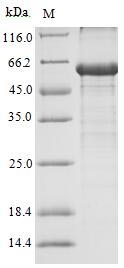Thanks for your response.
1. The other SUMO-tagged proteins we expressed have been successfully digested with our self-produced SUMO enzyme before.
However, we haven't tried to removed tag from this fusion protein using SUMO enzyme yet. If you have interest, you could have a try.
2. Our self-produced SUMO enzyme is as follows. Code: CSB-EP311619SVG Name: Recombinant Saccharomyces cerevisiae Ubiquitin-like-specific protease 1(ULP1) ,partial
We generally use this protein to remove SUMO-tag. LifeSensors has three SUMO enzymes (SUMO protease1, SUMO Protease 2, and SUMOstar Protease from LifeSensors). Our self-produced SUMO enzyme Ulp1, corresponding to SUMO protease1 from the company LifeSensors.
3. Wikipedia shows "Hydrolysis of the alpha-linked peptide bond in the sequence Gly-Gly-!Ala-Thr-Tyr at the C-terminal end of the small ubiquitin-like modifier (SUMO) propeptide, Smt3".
Here is the link: https://en.wikipedia.org/wiki/Ulp1_peptidase Therefore, GG is the cleavage site of the SUMO enzyme. We used the expression vector pet 28a-sumo to introduce thrombin cleavage sites, where R is the cleavage site (LVPRGS). The customer could also try thrombin cleavage and resection, but we cannot be 100% sure that it can be removed.
The sequence of the fusion protein with pET28a-sumo-10xhis/myc is as below.
MAHHHHHHMSDSEVNQEAKPEVKPEVKPETHINLKVSDGSSEIFFKIKKTTPLRRLMEAFAKRQGKEMDSLRFLYDGIRIQADQTPEDLDMEDNDIIEAHREQIGGGSHHHHHHHHHHLVPRGSRT+ Target Protein + AAAEQKLISEEDL-




